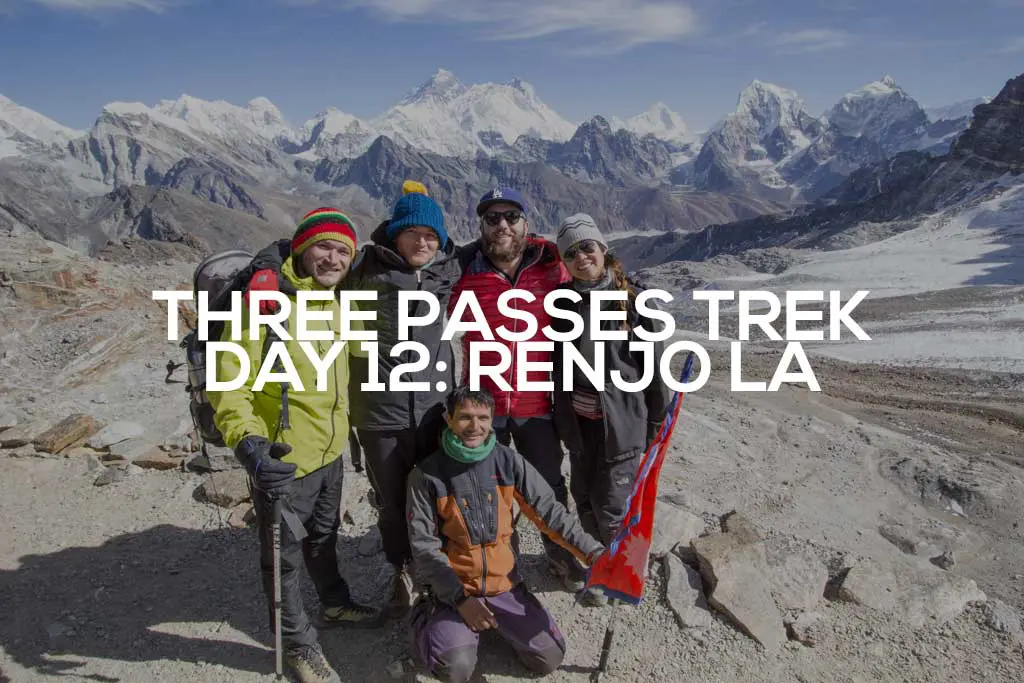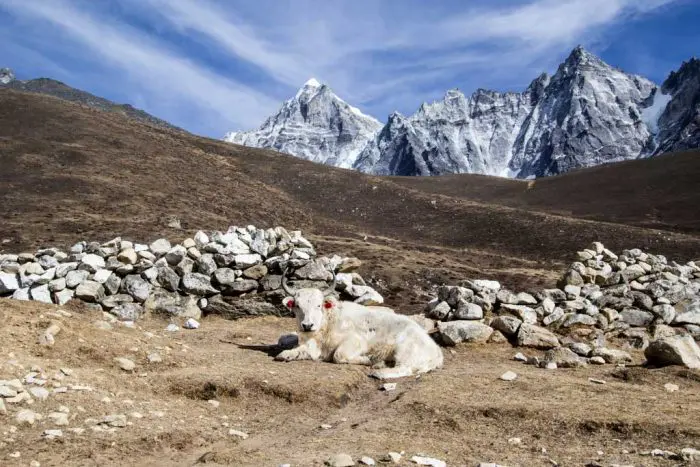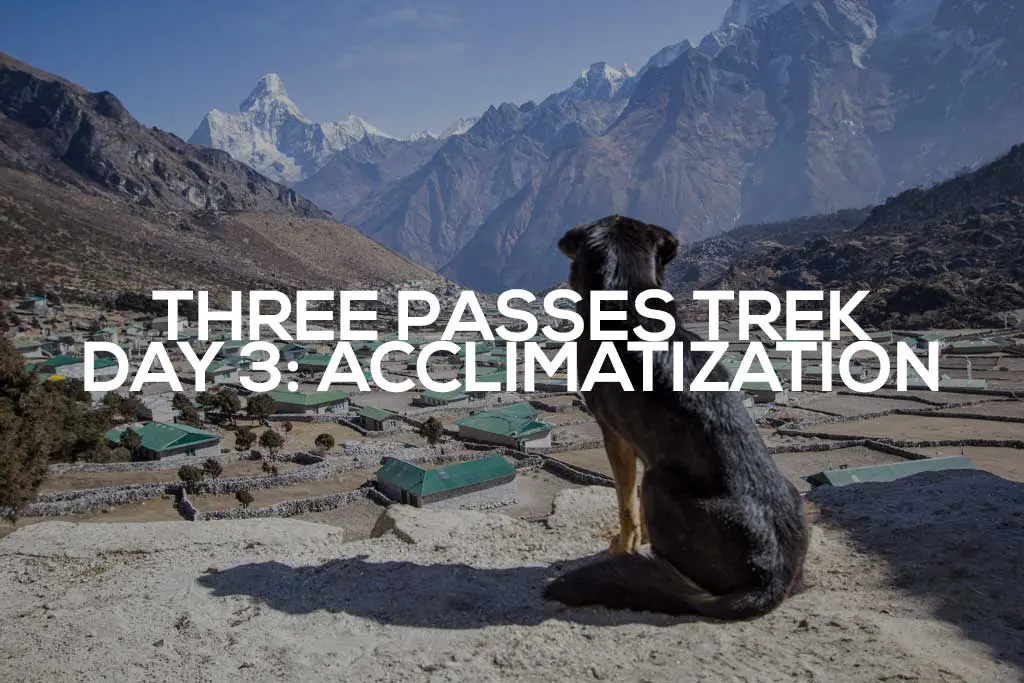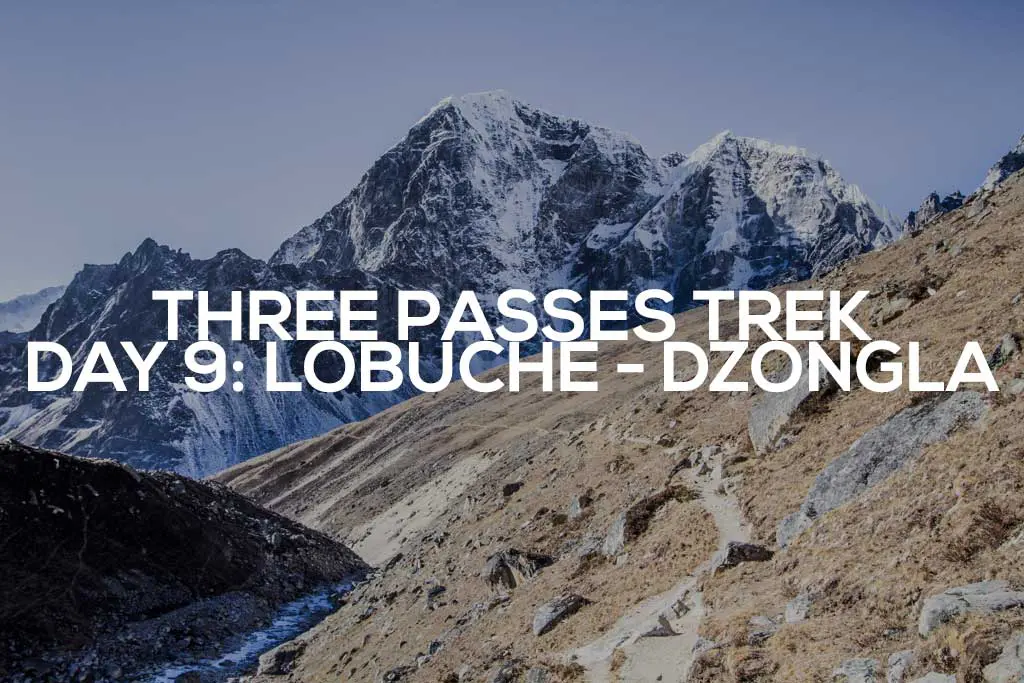Three Passes Trek Day 12: Renjo La (Gokyo to Thame)
This morning, I am happy to find the clouds responsible for last night’s snow have vacated the area and left blue skies in their wake.
Despite my originally wanting to put food into my mouth hole at 6:00 this morning (and then compromising for 6:30), nothing emerges from the kitchen until 7:15. Some advice: if you’re trying to make it out of a lodge early, make sure you leave things very clear with the owner. That, or be prepared not to eat your breakfast.
But I need my morning nutrition this morning because I’m heading over the third and final pass of the Three Passes Trek, Renjo La.
Most of last night’s snow has already melted, but a layer still coats the lake just west of the village. Three groups of hikers (two with guides and porters) are also heading over the pass this morning, and as we head out of the lodge along the lake’s northern shore, we slowly begin to climb.
Once past the lake, the trail climbs steeply up to a relatively flat area that resembles a large crater. If you were looking to camp, this would not be a bad spot (although you by no means need to camp at any point during this trek, and everyone will think you’re crazy if you choose to do so).
The other trekkers and I have all fallen into our rhythms and (fortunately) one group is ahead of me (aka I am not 100% sure of where I am going). Even in winter, which I am told is a low season, if you really thought you needed a guide, you would still (probably) be able to follow another group; it’s been rare to find myself alone out here.
As I walk across what I’m fairly certain is now the moon, the trail continues to climb slowly—a climb that might as well be a 40% grade at this altitude. Breathing is not easy.

Eventually, I can make out the prayer flags marking the pass. It’s a lot further than I would have liked to imagine.
The trail remains gradual until it’s almost directly below Renjo La, then it begins to climb steeply (and I begin to walk slowly). It’s a struggle to make it to the top, but I’ve fallen into the habit of taking one step per inhalation/exhalation cycle. It’s not the quickest way to get around, but it keeps me moving (consistency is key).
Knowing that the rest of the day (and the rest of the hike, really) will be entirely downhill, I summon the energy to push to the top without looking as if I’m in danger of collapsing (although I very well may be).
With the winter weather cooperating, our small crew atop Renjo La is rewarded with views of Makalu, Tengi Ragi Tau, the Rolwaling Range, and Gyachung Kang (and if none of that means anything to you, just replace it all with “fucking awesome mountains”).
Despite the labor-intensive effort at the end of my climb to the 17,585 ft / 5,360 m Renjo La, this was the easiest of the three passes. The approach and climb up Kongma La (the first pass) was long and demanding; the climb over Cho La (the second pass) was a sketchier since it involved an icy glacier crossing (and was also longer than Renjo La).
In addition, hiking the Three Passes Trek counterclockwise (the way I am hiking), Gokyo to Renjo La has the smallest elevation gain at 1,870 ft / 570 m (Kongma La is 2,641 ft / 805 m up from Chukhung and Cho La is 1,936 ft / 590 m up from Dzongla).

Descending west over Renjo La, I’m surprised to find some remarkable trail work – large steps have been built into the mountain descending from the top of the pass. As much as I hate steps, I am too impressed by the infrastructure to complain (and I’m heading downhill, so I don’t care).
I find myself off trail a couple of times during my descent and have to cut across some sketchy scree fields to get back to the main track (there are plenty of cairns, but it would seem that not all of them lead to salvation).
Soon, the steep western slope meets the valley floor, where the trail flattens out and follows a stream past a series of small (and very frozen) alpine lakes.
Most hikers (at least the ones I’ve spoken to) finish today in the village of Lumde – where apparently at least one lodge is open during the winter (Note: Lumde, how it appears on my map, is also written Lunden because the Sherpa language is unwritten). The valley on the west side of Renjo La is less traveled than those leading up to Gokyo or Lobuche/Chukhung, and you can expect fewer facilities.
There are yak (or at least what I am assuming are yak) wandering (seemingly freely) all over the Himalayas. Today, as I try to stick to the trail to Lumde, I get caught in the middle of what can accurately be described as a yak drive. I literally have to dodge yak running down the hill perpendicular to the trail (these beasts are mighty).
This is possibly the most frightening thing that’s happened on this trail (except for that little incident crossing Cho La).
Clear of the yak (the plural of which is both yaks and yak), I reach Lumde (about 4.3 mi / 7 km after Renjo La), where I catch up with everyone who went over the pass this morning. My fellow adventurers decide to stop and eat in the south of the village (it looks like it’s the only place open); I keep walking.
I’ll probably never see any of them again (my guess is they are staying here).
I can feel blisters forming on the balls of my feet, but my current plan of “just ignore them” seems to be working well enough.
In spite of my tender feet, hiking has grown exponentially easier because now, in addition to heading downhill, I can breathe. The elevation at Lumde, where I just left, is 14,333 ft / 4,369 m, and although that may seem high, it’s the lowest elevation I’ve been at since before Dingboche on day five (today is day twelve).
The trail stays on the east side of the river, and although I get a bit lost walking through the village of Dinjung or Marulung (I’m not sure if it’s one, the other, or both), I soon find my way again. I could have just asked someone in the village, but it appears that the entire place has been abandoned for the winter (or maybe forever?).
Speaking of not seeing anyone, I have not seen anyone heading north up this valley today, nor did I see anyone heading east over Renjo La; as I said, this valley is not as well-traveled.
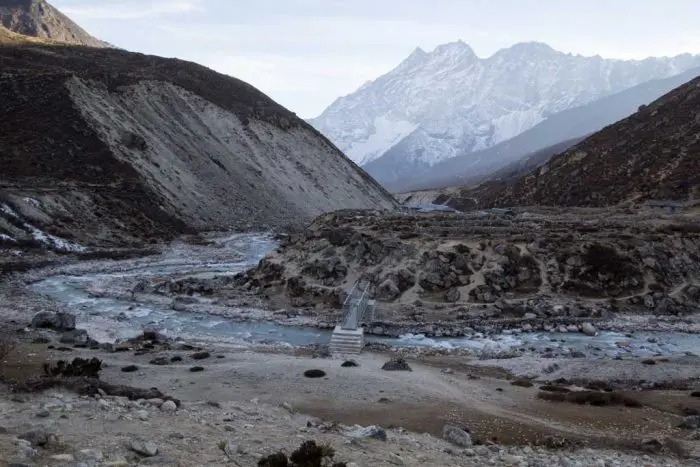
It’s starting to get dark (something that can happen quite early in Himalayan valleys when you’re surrounded by massive mountains), and looking at my map tells me I should be able to make it to the village of Thame before the darkness consumes me.
As I race the sun down the valley, I continue past empty villages (or at least very quiet villages). I’m not doing very well, and it looks like the sun will win this one. By the time I make it to the hill overlooking Thame, it’s practically dark. By the time I make it down the hill to the village, it is dark.
Wandering through the darkness, looking for anywhere that looks like it might be a lodge, I encounter two elderly women – unfortunately, my Nepali is a little rusty and I’m unable to do much communicating with them. But one of them appears to be interested in one particular direction and so I follow the road that way until I see a building with a single outdoor light on.
I go inside.

Happily, I find that I have not just invaded someone’s home. The person I see when I step inside is not a homeowner fearing for his life but a lodge owner surprised by my late arrival.
Two liters of tea and a plate of cheese-covered pasta later, and life is good.
My longest day of the Three Passes Trek is officially complete.
Tomorrow could be a short day back to Namche Bazaar.
Or maybe I’ll go back to the Lukla Airport?
But now, must sleep.
- Start: Gokyo (15,715 ft / 4,790 m)
- Start: Thame (12,533 ft / 3,820 m)
- Distance: 13.7 mi / 22.01 km
- Sleeping elevation change: -3,182 ft / 970 m
- Day’s elevation gain: +3,215 ft / 980 m
- Total time: 9:41:05
THREE PASSES TREK DAY: 1 | 2 | 3 | 4 | 5 | 6 | 7 | 8 | 9 | 10 | 12 | 13
Note: to those of you jumping around and reading these posts to get an idea of my itinerary: know that today, from Gokyo to Thame over Renjo La (the final of the three passes – heading counterclockwise), was a monster day (there are places to stop between Renjo La and Thame – like Lumde) and you by no means have to do this stretch in a single day. Also, I have no guarantee that this route is correct nor that it can be accurately relied upon for navigation. It should serve only as a general guideline for what the trail is expected to look like.
